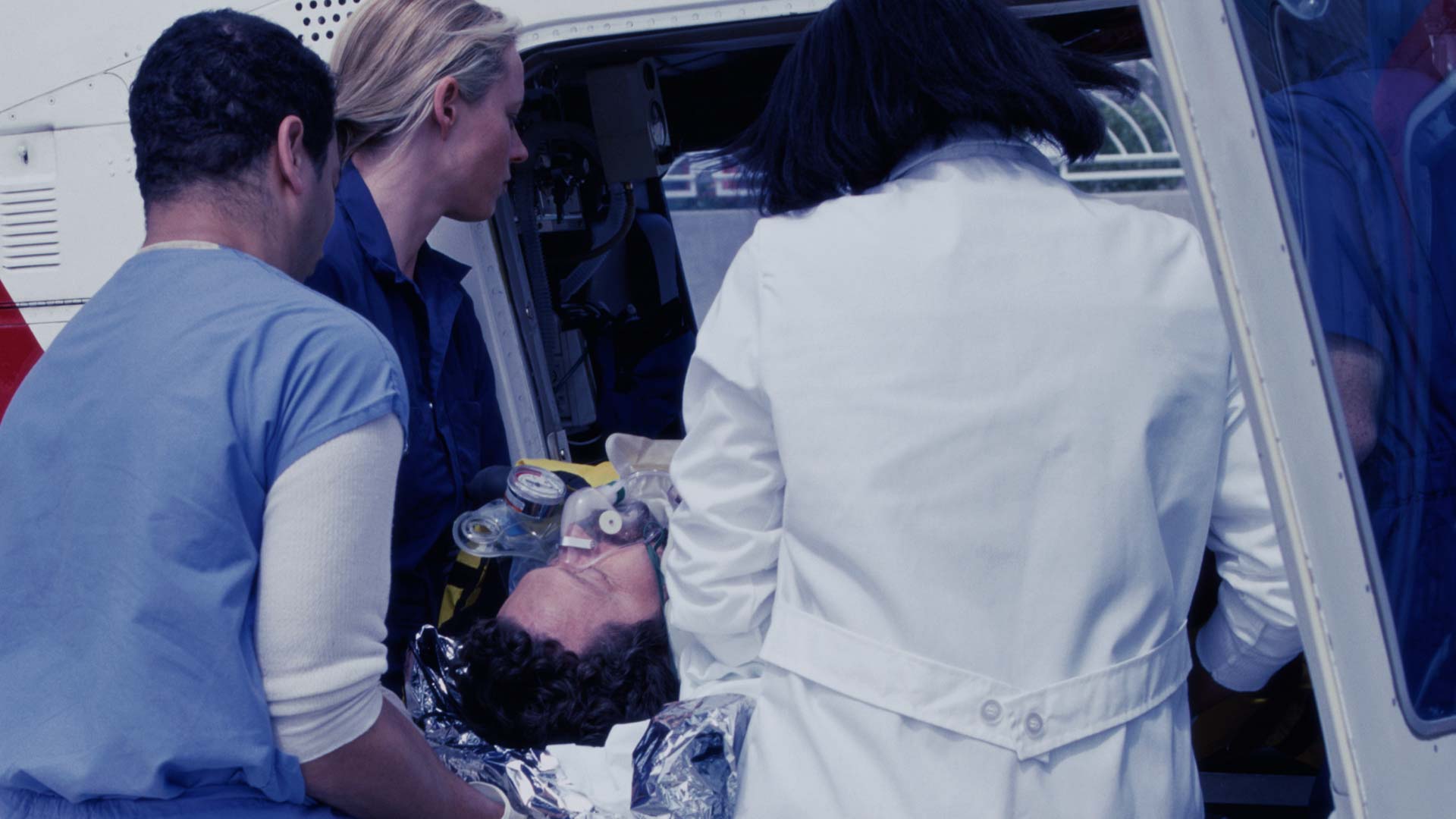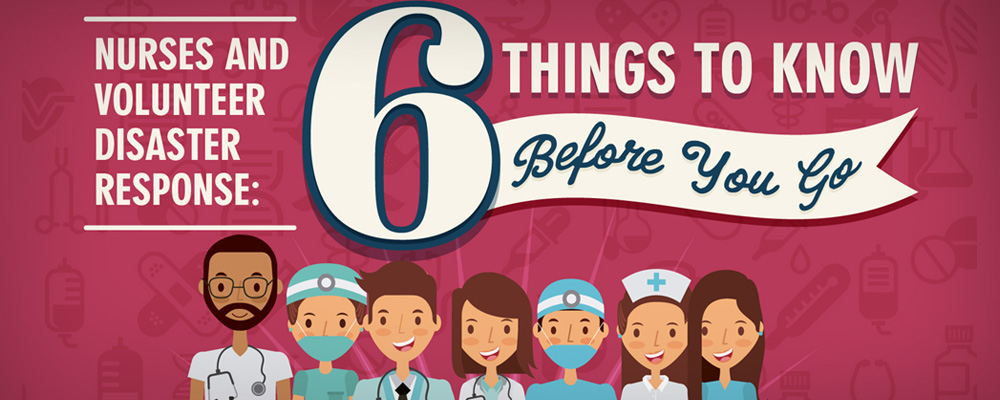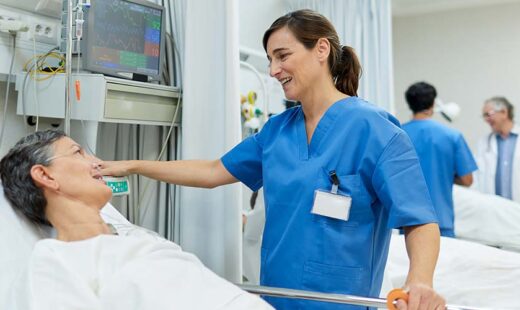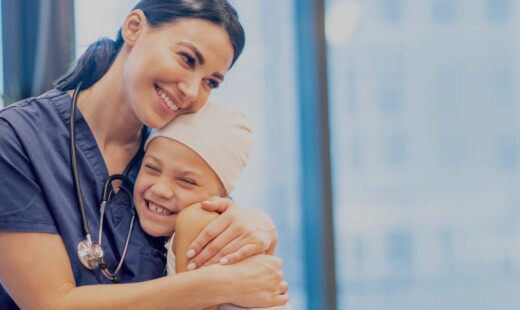Click here to see our full infographic
The call went out some 36 hours before the storm. It was simple, and scary, and sad all at once — a declaration of need, but also a harbinger of need to come.
On the evening of Sept. 8, in advance of Hurricane Irma’s arrival in Florida, Gov. Rick Scott tweeted:
“CALLING ALL NURSES: FL needs 1,000 volunteer nurses to help at our special needs shelters.”
The governor earnestly repeated the call on national news programs throughout the following day.
Florida designates emergency special needs shelters to accommodate individuals whose medical needs exceed the services typically available at shelters for the general population. Special needs shelters are open to people whose health conditions require access to electricity and those with cognitive impairment.
Such shelters are a priority in a state named one of the country’s grayest by the Pew Research Center. Nearly 20% of Florida’s population is age 65 and older.
Nurses who answered the call to volunteer in both the special needs shelters, as well as the nearly 400 general population shelters hastily created by the state, likely will have saved lives. Not by plucking stranded people from rooftops or participating in dramatic life-saving measures in hospital emergency departments, but by quietly and diligently attending to the healthcare needs of a displaced and frightened population — ensuring medications were taken and medical equipment was working, assessing for illness or acute stress, or preventing patients with dementia from straying into the tempest.
But in a state that likens its significant and ongoing need for RNs to a “nursing shortage tsunami,” one wonders whether Florida will have enough nurses to perform these and so many other patient care duties in the aftermath of Irma. Will another call for nursing expertise go out in weeks or months to come? And after the captivating drama of the storm has passed, would that call be heard?
Attention Deficit
For better or worse, we forward-leaning Americans have a tendency to move on to THE NEXT BIG THING. The habit applies to tech gadgets and TV series, but natural disasters, too. After the flood, the earthquake, or the fire, after the last televised rescue and the final heartbreaking images fade from our screens, we typically turn our attention elsewhere.
Witness the Houston area, where Hurricane Harvey power-punched the Texas and Louisiana coasts in late August before parking above populated areas and unleashing an epic, days-long torrent of rain. As Harvey finally made its exit and the floodwaters receded, so, too, had our rapt attention to the calamity.
To give credit where it’s due, the resilience of Gulf Coast residents in the face of heavy hardship might account for some of our distraction. And to be fair, it certainly hadn’t helped us train our attention on the aftermath of Harvey’s havoc when, just two weeks later, Irma, a historic and ironically near-Texas-sized hell-raiser, slammed into parts of the Caribbean and the entire state of Florida.
Like us, hurricanes move on; but the devastation that storms on the scale of Harvey and Irma leave in their wake — to infrastructure and, importantly, public and mental health — can linger for months, even years.
Past Lessons
The immediate response to Harvey was as effective as might be expected amid a non-stop deluge of water. A collective memory of previous storms — the infamous Hurricane Katrina in 2005, but also Hurricane Rita in the same year and 2001’s Tropical Storm Allison, both of which hit Texas with tragic results— offered vital lessons. Houston-area hospitals were better prepared for Harvey’s onslaught than their counterparts were a decade ago. A few hospitals, for example, employed a post-Allison preventive measure, deploying submarine-type doors to seal off flooded lower floors. Well-rehearsed, Katrina-inspired disaster cooperation between facilities, government agencies, and healthcare professionals paid off as hospitals and their staff weathered power outages or, in some cases, evacuated patients, all while enduring brutally long shifts.
With images of Katrina’s aftermath in mind, volunteers from near and far descended into the flood to rescue the stranded. Nurses from Southern California to New Jersey waded in, spelling local RNs from round-the-clock shifts and dispensing much-needed tetanus shots and sturdy shoulders to cry on in packed emergency shelters. Texas, another state potentially facing a crippling nursing shortage, looked beyond its borders for assistance. The Texas Board of Nursing issued temporary nursing licenses to more than 600 out-of-state nurses who hurried to help.
Florida had its own former teachers: Hurricane Andrew, a Category 5 monster that leveled southern portions of the state in 1992, followed by devastating Hurricanes Charlie (2004), Wilma (2005), and Mathew (2016). Battle-tested Southern Florida hospitals and nursing homes either closed facilities and evacuated patients in advance of Irma, restricted patient access, or stocked up on supplies and staff in preparation for the melee. Hospitals that remained open juggled readiness with treating an influx of patients with traumatic injuries sustained during their own storm preparations (installing hurricane shutters or fortifying roofs on their homes, for example) and a host of imminent moms-to-be (spontaneous deliveries have been linked to dropping barometric pressure during severe storms).
Immediate Health Concerns
But hurricanes and other assaults by Mother Nature have taught policymakers and the public health community something else, as well: Sometimes what comes after the disaster can be as bad and far-reaching as the disaster itself.
Public health crises following catastrophes don’t usually herald their arrival with high winds and storm surges; often they develop more insidiously over time.
Declaring a public health emergency in Texas, federal and state government officials began highlighting the health consequences of exposure to floodwaters. Far from simple rivers of rain, those floodwaters became a toxic soup of sewage, chemicals, vermin, and other hazards, such as metal or glass debris, through which people had waded, often chest-high in the rancid cauldron. Water tested by Texas A & M University found disturbing levels of E. coli in the floodwaters surrounding Houston — as much as 15 times the level considered safe for wading. Florida expected to find its floodwaters similarly compromised.
While outbreaks of waterborne diseases like cholera, yellow fever, or typhoid have been deemed highly unlikely in flooded areas of both states, health officials were on the lookout for illness caused by Vibrio pathogen, the so-called flesh-eating bacteria, along with salmonella, Norovirus, Rotavirus, and cryptosporidium infection. Houston hospitals did report an uptick in patients seen for skin rashes and respiratory infections. Florida, in particular, will keep a close eye trained on a possible resurgence of the mosquito-borne Zika virus.
Mindful of Katrina’s aftermath, health officials also continue to watch for outbreaks of contagious illness, including MRSA, among evacuees who had tightly clustered in storm shelters, as well as drug availability and access. Following the storm, people with chronic illnesses, including diabetes, hypertension, and asthma, faced impeded access to medication. Houston, for example, saw a spike in demand for insulin.
Long-term Worries
In the longer term, public health in both states faces daunting challenges. Stagnant floodwaters could give rise to mosquito-borne disease beyond Zika, such West Nile and dengue; and officials anticipate a rise in respiratory illness associated with exposure to post-flood, mold-laden homes and businesses. Houston, a petrochemical hub for the U.S., could see respiratory and other illnesses mount for some time to come as flooded industrial facilities and hazardous waste sites released pollutants into the atmosphere and water. At the time of this writing, more than 50 Florida superfund waste sites were at risk of spills.
Using Katrina as a guide, particular attention in both states may need to be shifted to the health needs of elderly and other vulnerable populations. Studies conducted in Katrina’s aftermath found that resilience and recovery following the disaster varied by age; but the highest mortality was seen among older individuals in the first year post-storm.
Studies also show resiliency might be stretched only so far. As much as 50% of people caught up in catastrophic natural disasters develop clinically significant signs of distress ranging from somatic disturbance and general anxiety to depression and post-traumatic stress. At the one-year mark post-Katrina, researchers discovered the incidence of suicidal thoughts among survivors more than doubled from 2% to 6%. The prevalence of major depression and PTSD among those affected by the catastrophe also grew over time, rising from 15% in the months following the disaster to 21% a year later.
Such psychological scars can be stubborn to heal. Even 10 years after Katrina, Louisiana residents were found to struggle with storm-induced or -exacerbated mental health challenges.
How You Can Still Help
Nurses know that recovery can be a slow and arduous process for individuals. The same can be said for communities devastated by disaster.
Consider these ways to help the survivors of Hurricanes Harvey and Irma, immediately and over the long haul:
- Donate now.
Back-to-back hurricane catastrophes, not to mention apocalyptic-looking wildfires in Montana and other parts of the West, have begun to strain the resources of first responders, government agencies, and aid organizations. The Federal Emergency Management Agency already characterizes housing in the Houston area alone as a long-term, costly mission.
Aid agency and watchdog groups recommend monetary donations versus durable goods to avoid unnecessary stockpiles and allow relief organizations to instead purchase community-specific materials as needed. To find reputable charity organizations and avoid scams, see these vetted lists for Harvey and Irma.
- Donate Later.
Thirteen million Americans went online to donate money toward relief efforts in the immediate aftermath of Katrina; but although the effects of the storm lingered into the succeeding years, longer-term charitable contributions slowed to a trickle.
The holidays are approaching. Give thought to donating to Harvey and Irma recovery efforts in the name of a family member, friend, or colleague as a gift. It works for birthdays, too. And don’t forget Irma’s impact on parts of the Caribbean and the one-two punch of a major earthquake and hurricane that Mexico suffered in September.
- Remember your colleagues.
Beyond the long hours and strain of participating in disaster response and recovery efforts, nurses have been victims of the storms, too. Many have lost their homes and belongings; some are temporarily out of work.
In connection with Operation Nurses Helping Nurses, a global network providing support to frontline caregivers during crises, the Texas Nurses Foundation is raising money to assist nurses personally affected by Hurricane Harvey. Watch for similar fundraising activities by the Florida Nurses Association.
Keep apprised of the needs of your colleagues by following both associations on Facebook and Twitter.
- Share stories.
Use social media to highlight the stories of nurses and others before, during, and after the hurricanes. Showcase their heroic efforts, and keep the conversation going about their needs and the needs of the communities they serve. Use your social channels to inspire your colleagues and the public at large to be disaster-ready and to consider volunteering during the next emergency event.
- Take time to serve as a temporary travel or volunteer nurse.
Travel nurse agencies are accepting applications for immediate and short-term assignments in the affected areas. The Texas Board of Nursing has expedited the issuance of temporary nursing licenses for disaster relief operations. Additional information about volunteering can be found at the Texas Disaster Volunteer Registry.
Like Texas, Florida participates in the Nursing Licensure Compact. As this post was written, the state was accepting nurse volunteers with active licenses. Email mailto:bprchdpreparedness@flhealth.gov or call (850) 245-4829 for information.
The Next Time
Neither nature nor man-made catastrophes operate on a timetable; they happen anywhere, nearly anytime. Be sure you’re ready to respond:
- Know the procedures.
If you’re not already well versed in your employer’s disaster preparedness and response procedures, learn them now. Contact your human resources department to be sure you have the most recent policies in hand. Give new attention to routine disaster drills.
- If you can, be ready to go.
If you’re willing and able to respond to the site of a disaster beyond your own community, ensure you’re adequately prepared for a trip — and what you may have to deal with upon your arrival. Strategize ahead of time with these tips for volunteering during disasters.
- Stay connected.
In Texas and Florida, organizations and individual nurses used social media channels, including Facebook and Twitter, to spread word of healthcare needs in disaster-stricken areas. Stay informed by following your nurse colleagues; your employer; and local, state, and national emergency response organizations on your own social media networks.
- Learn all you can.
An educated nurse is a ready nurse. Make it a point to seek out continuing education and other learning activities devoted to disaster preparedness and such topics as:
- Nurses’ duty to respond to disasters
- Legal and ethical issues in disaster response
- Waterborne diseases
- Communicable diseases
- Traumatic injury
- Crush injury/compartment syndrome
- Hypothermia
- Triage
- Senior care during disasters
- Psychosocial/behavioral aspects of disasters
- Bio- and radiological terrorism
- Active shooter response
In addition, the American Red Cross, the National Nurse Emergency Preparedness Initiative, and a variety of other government and private organizations offer disaster response training activities. Interprofessional certification in national healthcare disaster response is available through the American Nurses Credentialing Center.
Eisenhower Medical Center is committed to furthering the education of nurses on our team with no- and low-cost access to CE activities. Learn more at our Careers page.
Originally posted on 9/18/2017




